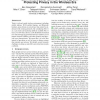Free Online Productivity Tools
i2Speak
i2Symbol
i2OCR
iTex2Img
iWeb2Print
iWeb2Shot
i2Type
iPdf2Split
iPdf2Merge
i2Bopomofo
i2Arabic
i2Style
i2Image
i2PDF
iLatex2Rtf
Sci2ools
HOTOS
2007
IEEE
2007
IEEE
Can Ferris Bueller Still Have His Day Off? Protecting Privacy in the Wireless Era
Today's rich and varied wireless environment, including mobile phones, Wi-Fi-enabled laptops, and Bluetooth headsets, poses threats to our privacy that cannot be addressed with existing protocols. By considering 802.11 as a case study and analyzing publicly available 802.11 traces, we show that a device can be identified and tracked over time through its persistent link-layer address, list of known networks (SSIDs), and other protocol and physical layer characteristics. We argue that it is in the best interest of providers as well as users to design systems that maintain user privacy. We identify several research challenges to doing so and offer some direction towards a solution.
Available 802.11 Traces | HOTOS 2007 | Operating System | Persistent Link-layer Address | Varied Wireless Environment |
| Added | 16 Aug 2010 |
| Updated | 16 Aug 2010 |
| Type | Conference |
| Year | 2007 |
| Where | HOTOS |
| Authors | Ben Greenstein, Ramakrishna Gummadi, Jeffrey Pang, Mike Y. Chen, Tadayoshi Kohno, Srinivasan Seshan, David Wetherall |
Comments (0)

